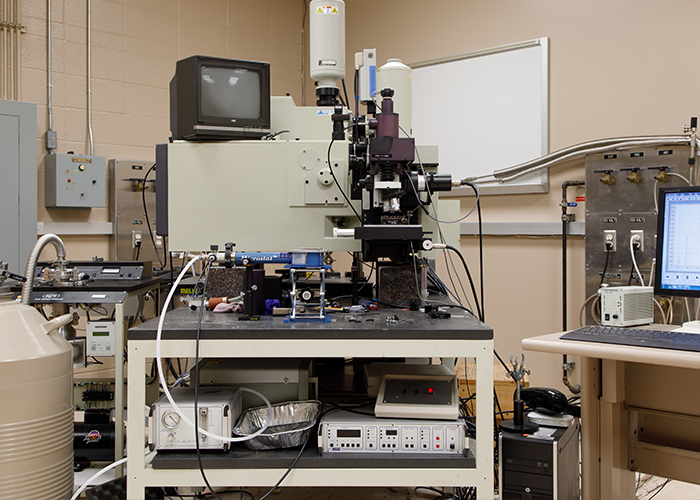
A state-of-the-art triple Raman spectrometer T64000 (Horiba Jobin Yvon) is equipped with two liquid nitrogen cooled CCDs, microscope, XYZ computer-controlled stage, and software for Raman imaging. The excitation sources are Ar+ (458, 488, and 515 nm), He-Ne (633 nm), and diode (784 nm) lasers. Temperature-dependent Raman spectra can be measured under microscope between 5 and 300K using an Oxford Instruments optical cryostat and between 300 and 900K using a Linkam heating stage. The FTIR Bomem D8A spectrometer, allows infrared reflectance and transmission measurements between 10 and 24,000 cm-1 with spectral resolution of 0.03 cm-1. It is equipped with a cryostat for low-temperature studies down to 4.2 K and a set of five detectors, including liquid He cooled bolometer.
Managed by Prof. Litvinchuk.
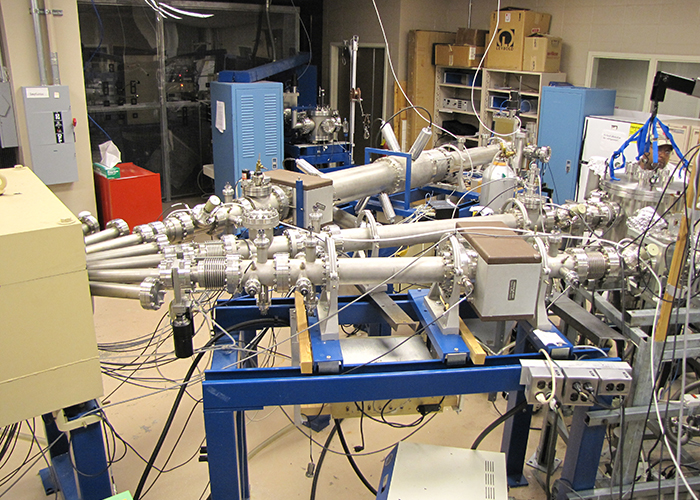
Includes a 2 x 1.7 MV Tandem Accelerator (RBS, ERD, NRA, Channeling, PIXE and MeV ion implantation facilities), a 30 KeV Gas cluster ion beam (GCIB) system, and a 2000 keV Ion Implanter for material modification and basic research, rapid thermal annealing system and vacuum annealing furnace, a facility on vibration and torque measurements at low temperature, flywheel, bearings, and home-made levitation devices, a 9T superconducting magnet cryostat, magneto-optic imaging and magnetron sputtering systems, and laser ablation chambers. The Ion Beam Laboratory is capable of doping with 80 different elemental ion species and isotopes, and also introduces radiation damage to semiconductor substrates. In addition, the GCB system is capable of producing smooth surfaces down to 1 nm and nano-rippled surfaces for optical, surface, and biological applications. See http://www.uh.edu/~wkchu/
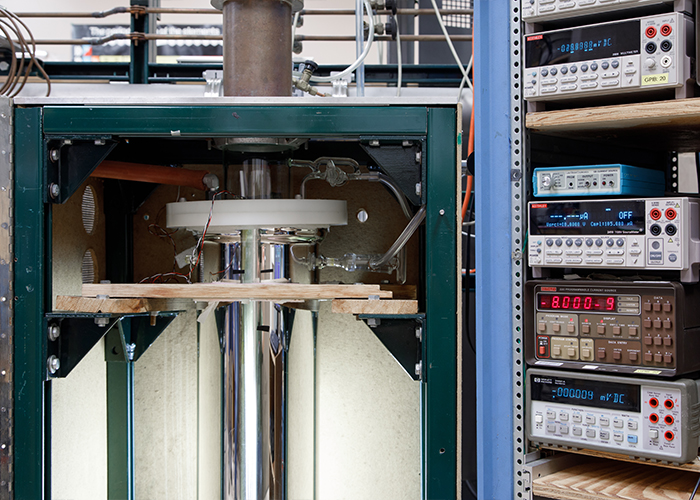
The HTS High Pressure & Low Temperature Physics Laboratory includes Low Temperature, High Pressure, High Field Capabilities: 1x10-2 to 6x10+2 K, 0 to 800 kbar, 0 to 16 T; He-4, He-3, dilution refrigerators, Be-Cu HP clamps, WC anvil cells, diamond anvil cells, superconducting magnets. Magnetic Measurements: SQUID (MPMS 3 – cryogen free & MPMS), pulsed magnetometer, ac susceptometer. Electrical Measurements: ac and dc, high and low current, high and low voltage, Hall coefficient, Seebeck coefficient, Nernst effect, and dielectric constant at various pressures and in various magnetic fields. Thermodynamic Measurements: Heat capacity, thermal expansion, thermal conductivity, HTS material processing and synthesis take place, equipped with a single crystal growth system, arc, and RF furnaces. Bulk materials are prepared in hot isostatic presses (200Mpa @ 1200 °C); thin film growth capabilities include DC and RF sputtering, thermal evaporation, laser ablation, and co-evaporation systems. X-ray diffractometer (TIGAKU) performed at T from 300 K down to 4.2 K. Raman spectrometer (Horiba-iHR550) with different types of laser as excitation sources (Nd-Yag: 1064 nm; He-Cd: 442 nm; He-Ne: 632.8 nm, 633 nm). Leica M205 C stereomicroscope with DFC450 digital color camera: resolution up to 0.95 µm, magnification up to 600, working distance of 61.5 mm. MBRAUM UNIlab Glove Box workstation equipped with Leica microscope for storing and handling sensitive materials and samples. The lab includes a 100 PSI jet mill for sub-micron particles and a continuous wire plastic extrusion apparatus.
Managed by Prof. Chu
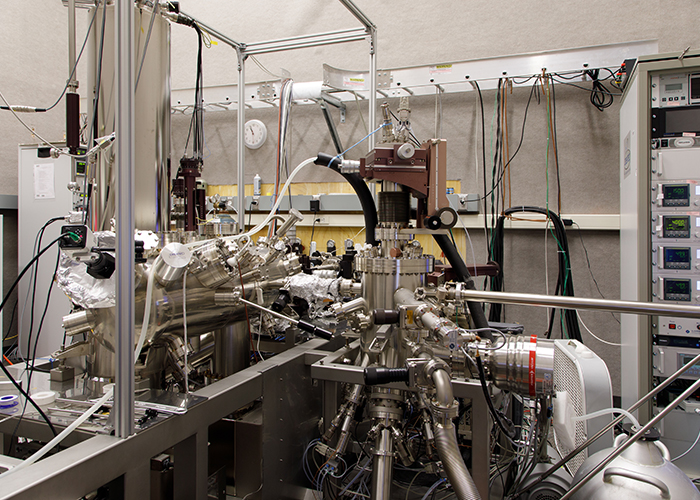
This laboratory has the capability to grow crystalline thin films in ultrahigh vacuum with precise control of thickness, composition, and morphology at temperatures up to 1300 °C. The deposition system is integrated with a scanning tunneling microscope for in situ electronic spectroscopic studies under a magnetic field up to 0.3 T and at temperature down to 6 K and low temperature capabilities for in situ magnetic and transport properties studies under magnetic fields up to 3 T and at temperature down to 1.2K.
Managed by Prof. Chu

Facilities include a reel-to-reel Metal Organic Chemical Vapor Deposition System, reel-to-reel Ion Beam Assisted Deposition systems (2) with ion beam sputtering (1) and e-beam evaporation (1), reel-to-reel magnetron sputtering systems (2); one with twin magnetron and r.f. sputtering. We have equipment for Zone Melting and Recrystallization, Hot Isostatic Pressing (HIP), Cold Isostatic Pressing (CIP), Spark Plasma Sintering (SPS) and Electrodeposition. We also have systems for transport critical current measurement and anisotropy measurement in magnetic field, an AC loss measurement, quench stability measurement and Instron systems for mechanical property measurement from cryogenic to elevated temperatures.
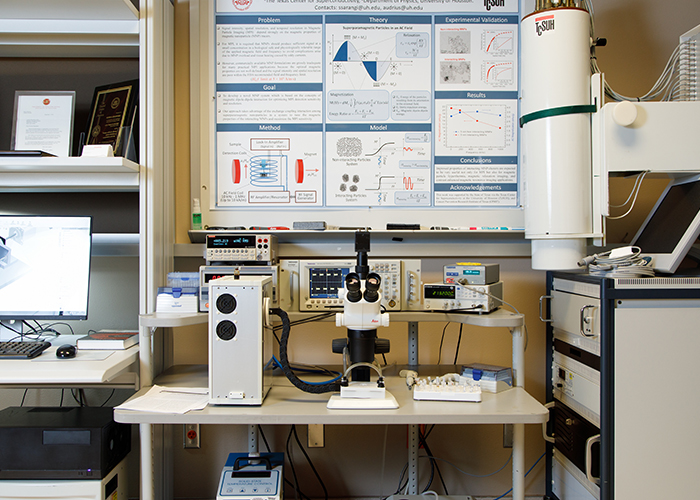
State-of-the-art magnetic hyperthermia instruments for invitro and invivo studies: a) 10 kA/m magnetic hyperthermia system (100 kHz to 1 MHz), equipped with a 45 mm diameter field coil suitable for small animal research, and option for live cell imaging/exposure for time lapse imaging, and b) 50 kA/m magnetic hyperthermia system (300 kHz) with a 40 mm field coil suitable for small animal research in high magnetic fields. Laboratory is also equipped with state-of-the-art HTS and LTS SQUID instrumentation for single- and multi-channel biomagnetic signal acquisition, LTS SQUID imaging system with a sub-mm spatial resolution, X-Y translation stages, stereomicroscopes, vacuum systems, and general laboratory instruments (function/arbitrary waveform generators, dynamic signal analyzers, lock-in-amplifiers, digital oscilloscopes, etc.). Laboratory is also equipped with several workstations complete with licenses for Matlab®, Labview®, Comsol®, and a computer-aided design (CAD) software, Solid Works® for mechanical design.
Managed by Prof. Brazdeikis
Facilities include a small transmit and receiving magnetic resonance imaging (MRI) set-up for imaging of small animals, and automated rf and microwave systems for microwave characterization at low and high power levels. The facilities include an HP sweeper, a HP scalar network analyzer, two HP vector network analyzers, and a TWT 150 Watts Varian microwave amplifier. The lab also has a Bruker 300 SE Electron Spin Resonance X-band spectrometer, modified for field-modulated microwave absorption measurements for characterization of the microwave properties of HTS grain boundary Josephson junctions and an ion beam and electron beam deposition system.
The Solid State Ionics Laboratory contains three systems for the determination of total or ionic conductivity and stoichiometry from 10-18 to 1 atm of O2 at T ≤ 1050 ºC. Each system uses a specially designed high-temperature probe in a vertical furnace and is equipped with current source, voltmeter and lock-in amplifier. Experiments are computer controlled with LabView. Five systems for electrical conductivity relaxation, dc and ac conductivity (Solatron 1260, HP4195A impedance analyzers) measurements are available.
Managed by A. J. Jacobson
Synthesis laboratories are equipped with six hoods for standard chemical synthesis, two purified-Ar atmosphere gloveboxes, and a vacuum Atmospheres dual glove box. Eight 200°C and two 350°C ovens and a Leco high-pressure system are available for hydrothermal synthesis. We have a Teflon sealer and large number of small and several large autoclaves for synthesis. A variety of furnaces are used for high-temperature synthesis. Two of these furnaces are set up with flow controllers and stainless steel lines for gas mixtures. Other furnaces include four Lindberg and four Thermolyne single zone tube furnaces also set up for synthesis in controlled atmospheres, two Deltech 1700°C tube furnaces, a Centorr Arc-furnace, and RF furnace and multiple box furnaces that operate from room temperature to 1000°C, 1200°C or 1700°C in air.
Analytical instrumentation for the characterization of materials includes two TA 2100 systems, a DuPont 990 TGA and a Netzsch STA 449 F3 Jupiter Simultaneous Thermal Analyzer (TG-DSC/DTA Apparatus) Temperature range: according to selected furnace RT to 2400°C, for Cp determination up to 1500°C with Tungsten & SiC Furnaces, Thermokinetics, QMS mass spec, and GC-ICP-MS and Differential Scanning Calorimeter (DSC); DSC-1, Star System, Mettler Toledo Inc. for operation between −150°C and 700 °C. Powder surface area measurements are made using a Micromeritics Gemini III 2375. A variety of equipment is available for electrochemistry including a Biologic MacPile 16 channel, Arbin MSTAT4 and PAR 173 potentiostats. An Oxford Maglab with a VSM (9T) and transport measurements, and a Quantum Design PPMS system for magnetic and specific heat measurements are available.
Managed by A. J. Jacobson
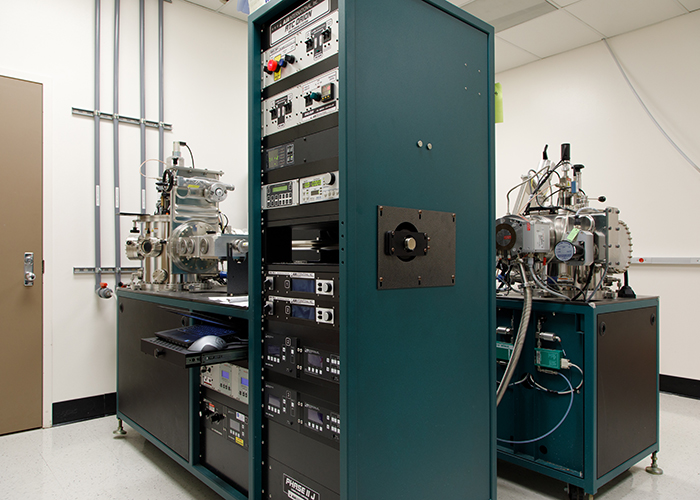
The Ren group has a 5000 sq. ft. materials fabrication and characterization laboratory that has equipment items for fabrication of nanoparticles, single crystal growth, thin film deposition, bulk materials synthesis, and physical property characterization. The major equipment include multiple high energy ball mill machines to make nanoparticles, multiple dual atmosphere controlled glove boxes to handle the nanoparticles, multiple dc/ac current induced hot presses to compact the nanoparticles into dense bulk samples up to three inches in diameter and at higher 2000 °C, multiple diamond saws to cut samples, multiple high temperature four-probe transport measurement systems to measure the electrical conductivity and Seebeck coefficient, one differential scanning calorimetry to measure the specific heat, one light flash system to measure the heat diffusivity and specific heat below 300 °C, one laser flash to measure the heat diffusivity and specific heat between 50 and 1200 °C, multiple high temperature ovens for annealing samples, one arc melter for making high temperature alloys, one melt spinner for making amorphous and nanomaterials, one solar simulators for solar thermoelectric efficiency measurement, one heat to electricity conversion measurement system, a Turbula mixer for uniform mixing of any nanoparticles, a furnace hot press, two multiple-target magnetron sputtering systems, multiple Muffle furnaces for making alloys of thermoelectric materials and heat treatment of samples, and one electrochemical deposition system.
Managed by Zhifeng Ren